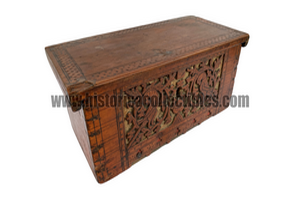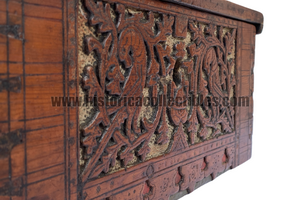Engraved and carved poplar wood casket with Phoenicians, (mythological birds) Florence, 15th Century, circa 1450
Poplar wood casket, artifact of Florentine origin dated to the first half of the 1400s, decorated with scratched and punched workmanship on all four sides as well as on the lid.
On the façade of the front panel, for three-quarters of its width, there is a low-relief carving consisting of two Phoenicians (mythological birds) positioned opposite each other within an intricate frame with a vegetal motif; the entire carved element is decorated on its surface with a dense and targeted stippling as if to give it a three-dimensional perspective while, on the entire profile, a dark pigment is still present.
Furthermore, some decorations carved on the lower part of the front panel are highlighted which, inside them, still contain distinguishable red and green pigmentations.
A structurally identical example, albeit with a carving of two leopards on the front, is preserved at the Victoria & Albert Museum with Accession Number W.25-1953, and was analyzed by Jo Darrah of the V&A Conservation dept. on 16/5/1986 who established, after careful observation under the microscope, that it is poplar wood (Populus sp.) and the polychrome pigment present in the decorations on the front appears to be made with vitreous material as regards the red while the blue pigment appears to be azurite with a copper salt. The green instead appears to be a copper resinate. The general conditions of the box are excellent and its original lock inserted inside is still present (a very rare event), perfectly functional.
Comparable wood casket:
- Claudio Paolini: Il mobile del rinascimento – La collezione Herbert Percy Horne. (Museo Horne, Florence, 2002), no. 15: alms box, cypress wood, 12.5 x 28.3 x 13cm
- Box, 12 x 27 x 11 cm, Museo dell'opera del Duomo, Orvieto, in Annarosa Garrelli, Musei d'Italia - Meraviglie d' Italia (Bologna, 1972), no. 347
- Another in the Bayerischesnationalmuseum, Munich (details unknown)
- See Miotti (1990) for comparable examples and hypothesis that this type of box is of Friulan origin, 15c.
- Tito Miotti , Nobiltá del mobile Friulano (Udine, 1990).
- María Paz Aguiló Alonso: El Mueble en España, Siglos XVI - XVII. (Madrid 1993), p.222, nos.. 94, 96, 97 (north Italian late 15th or 16th century)
- Coffer with two pelicans, 1500-1550 South Tyrol, 40 x 18 x 16.5cm, in Ewald Berger, Prunk-Kassetten/ Ornamental Caskets. Meisterwerke aus der Hanns Schell Collection. (Graz, 1998), no. 49
- Ferenc Batári, and Erzsébet Vadászi ; edited by Elvira Király : Art of furniture-making from the Gothic to the Biedermeier: European Furniture from the 15th to the 19th Century in the Nagytétény
- Castle Museum ([Budapest : Museum of Applied Arts], 2002.), no.1, p.13 (Perugia, late 14th century, 27.5 x 67 x 29cm)
- Referenze Bibliografiche:
- Peter Thornton, Cassoni, Forzieri, Goffani and Cassette: Terminology and its problems, in Apollo vol. CXX (1984), no.272 pp.246-251, fig. 4.


